A Day Tour in North Norfolk today. It was another lovely warm, sunny morning. It did cloud over early afternoon, and we had a brief shower, but it passed through very quickly and then brightened up again afterwards – not enough to put a dampener on another lovely spring day’s birding.
We headed out to Burnham Overy Dunes for the morning, with the warblers in and in full voice again. As we walked down the track, a Common Whitethroat was singing in the top of the hedge. Over the stile, a Lesser Whitethroat was rattling, with a Blackcap singing the other side and our first Sedge Warbler tucked down out of view in the brambles beside the ditch. A Cetti’s Warbler shouted at us and flew across the track, flashing its deep chestnut upperparts.
The grazing marshes by the track here are drying out fast. There were still a few Lapwings, with one displaying over the remaining muddy pools, and several Oystercatchers, but there are fewer waders than usual here. Five Golden Plover were walking around out on the short grass, moulting into summer plumage, with one in particular sporting a noticeable black face and belly.
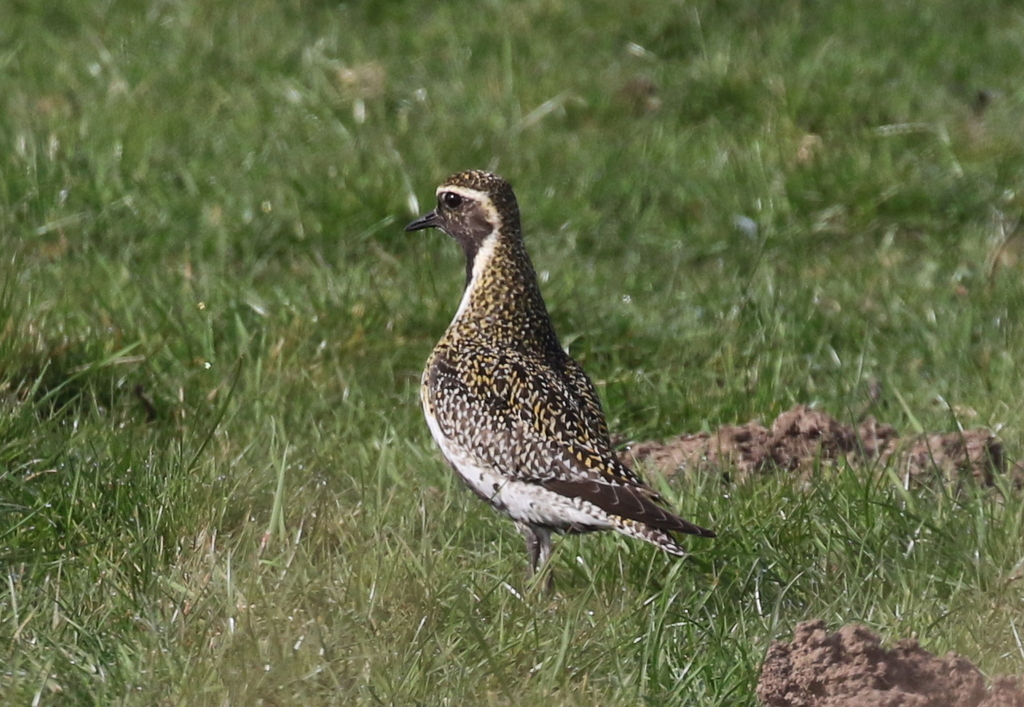
Continuing on down the track, we heard several more Sedge Warblers singing but they were hiding too and we had mostly glimpses. We heard a Grasshopper Warbler reeling ahead of us, and walked up slowly towards it. Scanning the brambles, we spotted it half hidden in the top of one clump. We got it in the scope and had a look at it. We were hoping to get a bit closer, but just at that point two Environment Agency vehicles came steaming down the track and it dived back into cover.
We carried on to the end of the track, where a more obliging Sedge Warbler was singing, climbing up to the top of a small briar, before songflighting over to the brambles by the seawall, singing from there for a bit and then songflighting back again. We stopped to watch it, getting a good look at its bold creamy white supercilium. The Grasshopper Warbler started reeling again, back along the track.
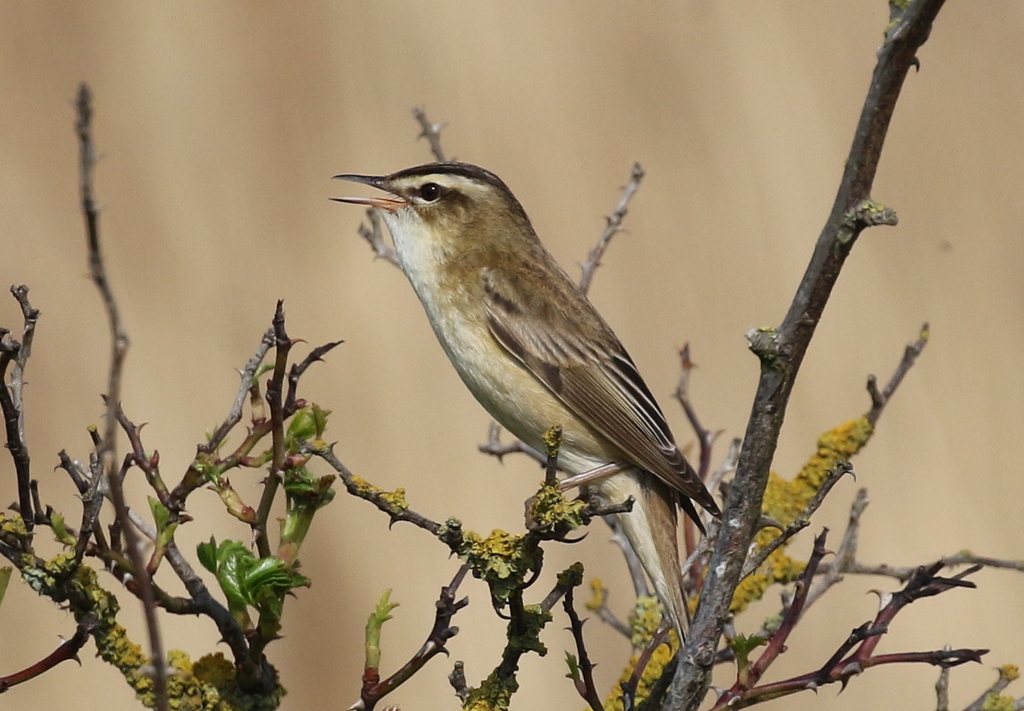
When we finally got up on the seawall, we could see why the Environment Agency workers had been in such a hurry – they were still sat in the vehicles drinking tea! They had come to mow the seawall, but had only got half the job done yesterday and were clearly in no hurry to finish.
The tide was in out in the harbour and there were a few waders roosting in the vegetation on the saltmarsh. We stopped to look at the Black-tailed Godwits, increasingly rusty as they moult into breeding plumage, and a single Grey Plover still in noon-breeding plumage. A small group of Turnstones were roosting further back, on the edge of the harbour channel. A pair of Mediterranean Gulls circled high over the harbour, calling.
As we walked on along the sea wall, we could hear a Reed Warbler singing in the reeds along the ditch below. Its rhythmic song was very different to the Sedge Warblers we had heard earlier. A large flock of Brent Geese flew in across the harbour and landed on the saltmarsh, lingering winter visitors. Two Whimbrel were feeding nearby. Slim, short-billed and dark brown, through the scope we could their distinctive central crown stripe too. A Sand Martin flew over, surprisingly the only hirundine we saw on the move again today.
Stopping on the last corner of the seawall, we scanned the grazing marshes. Three Wheatears were hoping around in the short grass. There is a bit more water still in the pools here, and some of the Lapwings here had small fluffy chicks which were feeding around the edges. We could see some ducks around the muddy margins too – a few lingering Wigeon and Teal, plus Shoveler, Mallard and Gadwall. Most of the Pink-footed Geese have long since departed north, but a gaggle of about 100 was still out on the marshes beyond, with a pair of Barnacle Geese too.
While watching the geese, one of the group spotted an Otter walking across the middle of the grass. The geese put their heads up, and the whole flock of Pink-footed Geese seemed to be shepherding the Otter. It flushed a Brown Hare from the grass too, which ran up and down in front of the geese. From time to time the Otter would lie down in the grass – we couldn’t tell whether it was resting or looking for something to eat, perhaps eggs or a young nestling?

Out at the boardwalk, a Chiffchaff was flitting around in the bushes, probably a freshly arrived migrant. Heading on into the dunes, there were lots of Linnets and Meadow Pipits feeding in the short grass. And lots more Wheatears, lingering migrants, feeding up before continuing journey north, flashing their white tails as they flew off ahead of us.
We walked up to the top of the first ridge and stopped to scan the dunes, but there was no sign of any Ring Ouzels here today. As we Continued on east, a Cuckoo flew off behind us, chased by Meadow Pipit. A pair of Stonechats were perched on the bushes and we spotted a Whinchat down on the grass just beyond the fence. While we were looking at it through the scope, it flew and we didn’t see where it went.
A Song Thrush was feeding on the top of the next ridge and when it flew back into a small holm oak just beyond, two darker birds flew in with it – Ring Ouzels. We could see a female tucked in the middle of the bush, with a brown-tinged pale gorget, though it was not a great view. They flew back down into the dunes so we walked up to the ridge to see if we could see them on the ground.
They are often very nervous and flighty here and as soon as we put our heads over the top, three Ring Ouzels flew off over dunes behind us calling. We thought that might be it, but then another one started chacking, still in the bushes. As we tried to get round to the other side, it flew out and helpfully landed in the top of some nearby brambles, where we could get a good look at it. It was a smart male, with a bright white gorget.

Looking out across the grazing meadows from the dunes, we could see a few Spoonbills distantly on the pool below the wood. Nearby, we could just make out two Cattle Egrets walking around with the cows. A Great White Egret was easier to see, standing on the edge of the reeds. Looking out the other way, towards the sea, a small flock of Common Scoter was flying past distantly offshore.
As we walked back through the dunes, there were still lots of Wheatears. One male perched on a fence post and didn’t fly off as we approached. We stopped to photograph it, then as we walked on, it stayed put. Eventually it allowed us to walk up until we were all just a few metres away from it. It seemed to like having its photo taken!

Back out on the seawall, the breeze had picked up noticeably. Two Red Kites hung in the air over the seawall, before drifting away over the grazing marshes. The Environment Agency workmen had already finished the small amount of mowing with their remote-controlled mowers and were now sat in the van eating sandwiches. Tough work!
Along the track back towards the road, there were more butterflies out now in the shelter of the hedges. We had seen a few Speckled Woods on our walk out, but now there were a few Orange Tips and Holly Blues too.
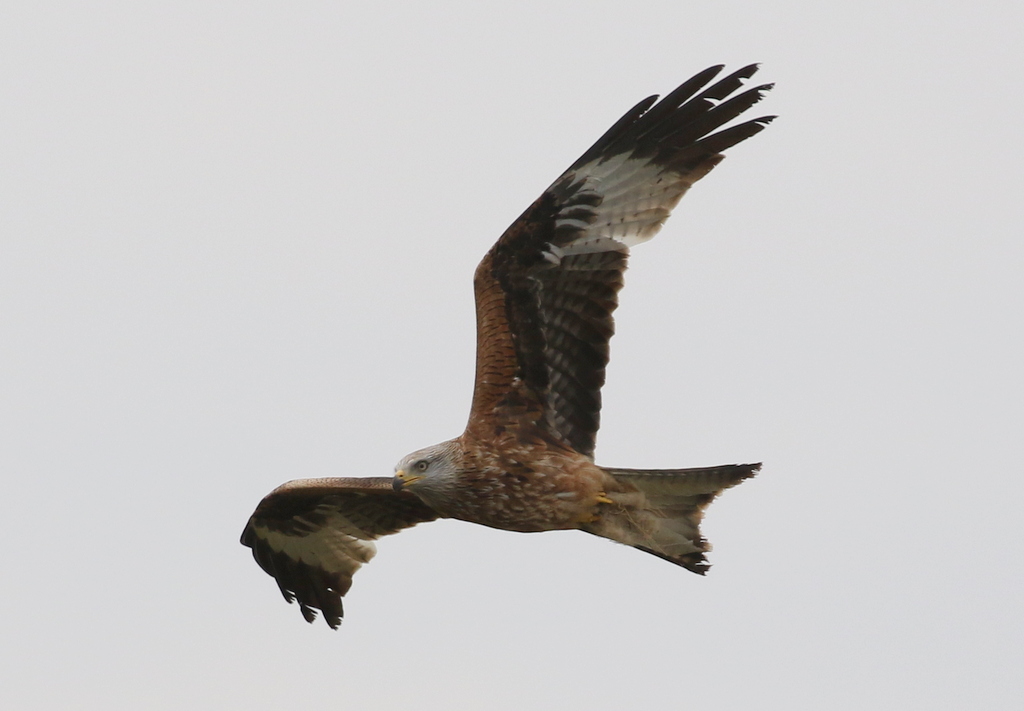
It was almost time for lunch, so we climbed back into the van, but on our way we drove round via a complex of old barns. As we passed we could see a shape in one of the window openings, so we turned round and stopped to admire a Little Owl perched sunning itself. It looked at us nervously, considered its options for a bit, then flew inside.
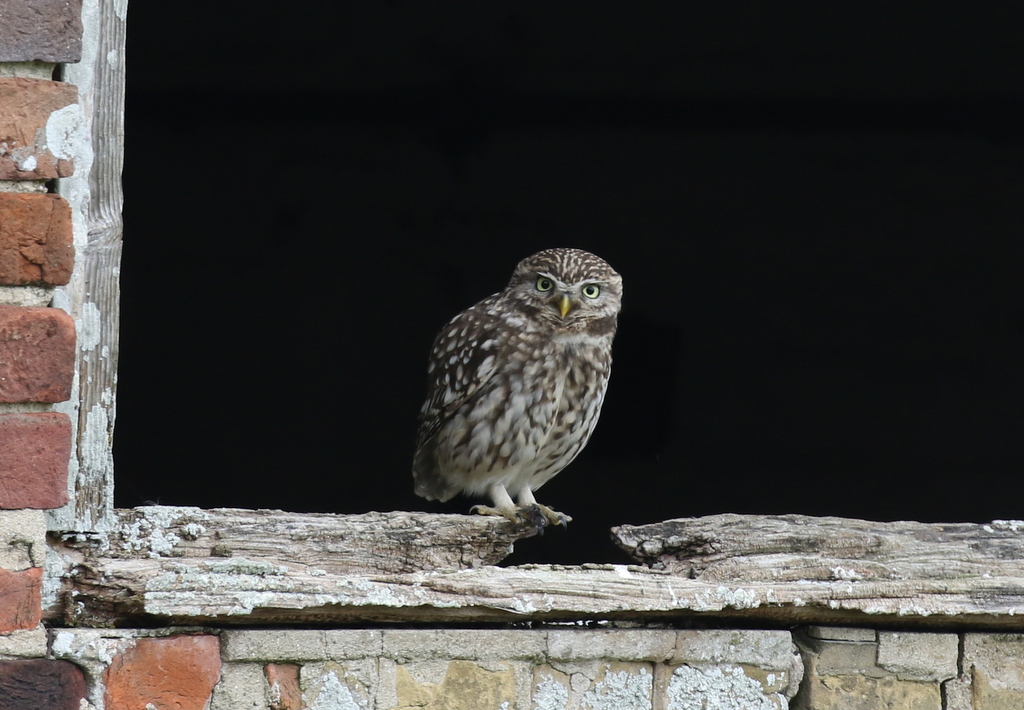
We went to Holkham for lunch, where we could use the facilities in The Lookout café and get a drink. Afterwards, a quick check of the pool in front revealed a Little Ringed Plover and a Pied Wagtail feeding around the edge. Two Mistle Thrushes were feeding out on the grazing marshes in front of the van.
Our first stop of the afternoon was at Wells. As we walked down the track, we could see lots of ducks on the pools – more Teal, Gadwall, Mallard, Shoveler, and one or two Wigeon still with them. A drake Garganey was feeding over towards the far side and when it raised its head from time to time we could see its bold white supercilium.
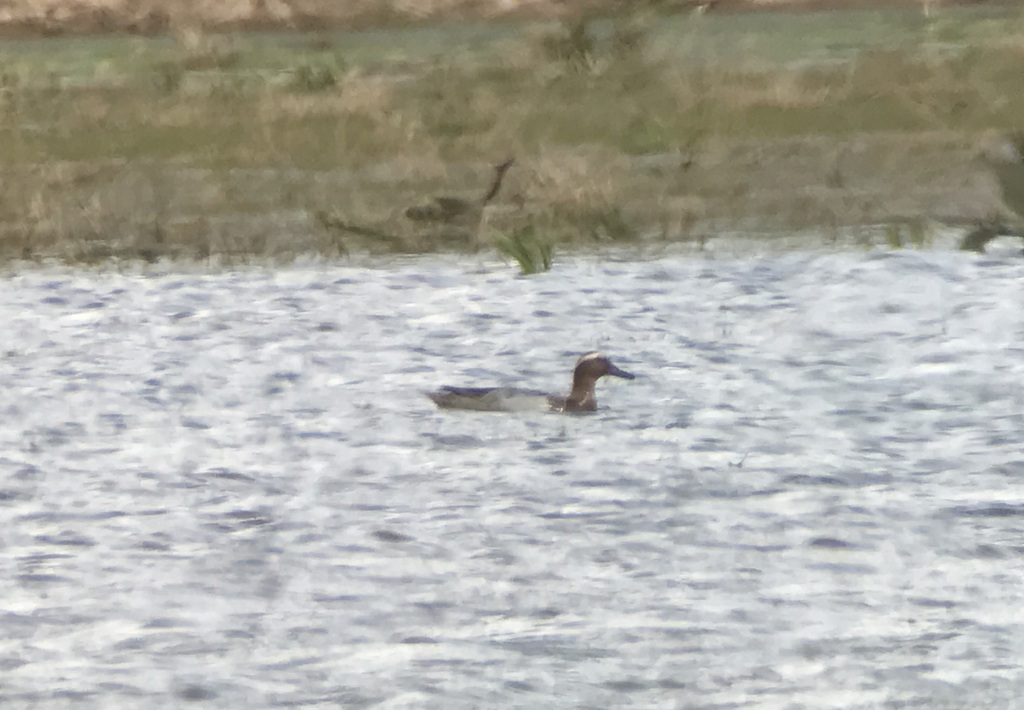
There were lots of spring passage waders on here too. We could see four Greenshanks together and then heard at least one more calling out of view away to our right. There were several Ruff, males which had mostly acquired their bright breeding plumage but not yet the ornate ruffs – although one had already lost its neck feathers in preparation. We got a rather dark blackish one in the scope for a closer look. A Common Sandpiper was bobbing its way along the far bank and a Common Snipe was hiding in the rushes in the middle.
Scanning the pools the other side of the track, we could see at least five Wood Sandpipers, with bright white spangled backs and well marked pale supercilium, although they kept disappearing into the wet grass. Four Spotted Redshanks were a little further back, a couple of them already getting quite dusky as they moult into breeding plumage.

It had clouded over now and we could see some rather dark clouds gathering just inland but we thought we had enough time for a quick look at westernmost pool. A Wood Sandpiper was on here too, but as the birds had been flying around it was hard to say whether it was one of the five or a different bird. There were lots of Avocets, but no sign of any Snipe in the grass here today.
We decided to try to walk back before the rain arrived, but we hadn’t got far before it began to spit. We got caught by the shower, but thankfully it wasn’t one of the forecast thundery downpours but just very brief and very light. It had dried up before we even got back to the van. A Grey Partridge was calling, and ran out onto the track.
Moving on to Stiffkey, a Brown Hare and several Skylarks were in the meadow opposite the layby, and we could hear Lesser Whitethroat and Blackcap singing as we walked down the path. A Willow Warbler in an oak tree by the road was giving a rather half-hearted rendition of its song, but we got a good look at it as it flitted around in the half emerged leaves. Down by the river, we found a pair of Long-tailed Tits.
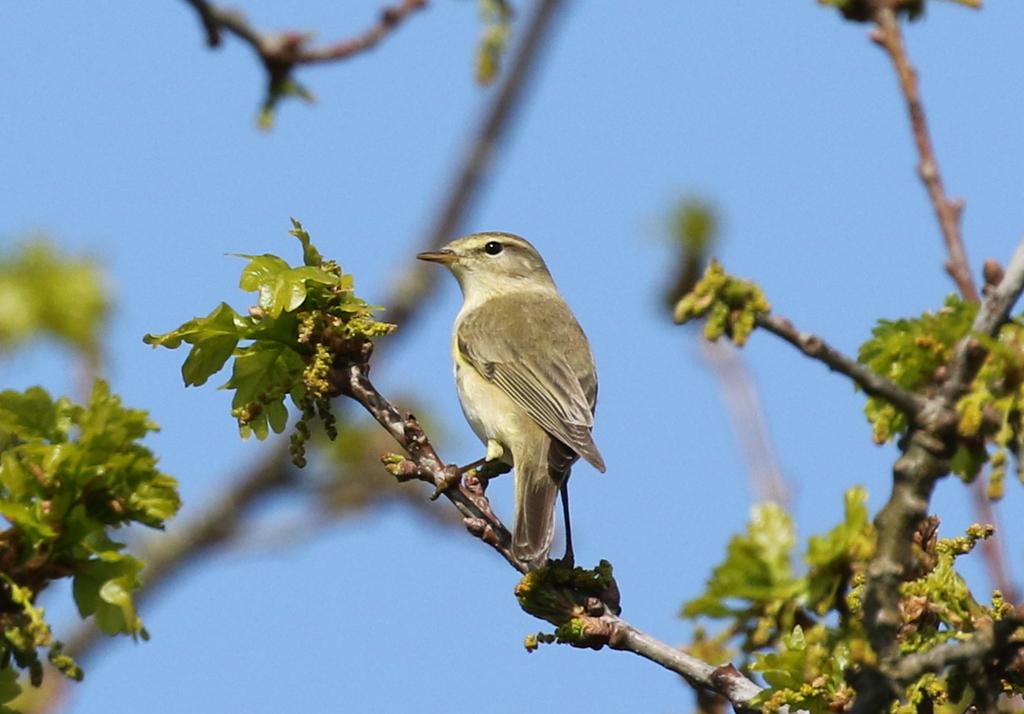
Looking across to the Fen from the path, we could see a Green Sandpiper at the back, against the reeds, and two Common Sandpipers. The Little Gull was still here, hawking out over the water, occasionally dipping down or soaring up, alternately flashing its bright silvery grey upperparts and blackish underwings.

From up on the seawall, we had a better view of the whole Fen. Several Black-tailed Godwits and Common Redshanks were roosting in the shallow water. Over to one side, we found a Spotted Redshank feeding on the mud as well, another dusky bird, and we had a nice side by side comparison in the scope with one of the Common Redshanks. We could get the Green Sandpiper in the scope from here too.
There were lots of Black-headed Gulls out on the Fen, but we heard Mediterranean Gulls calling behind us and looked round to see a pair flying in low over saltmarsh behind us and in over seawall. A male Marsh Harrier flew low over the Fen and flushed everything, including a Yellow Wagtail which flew round calling.
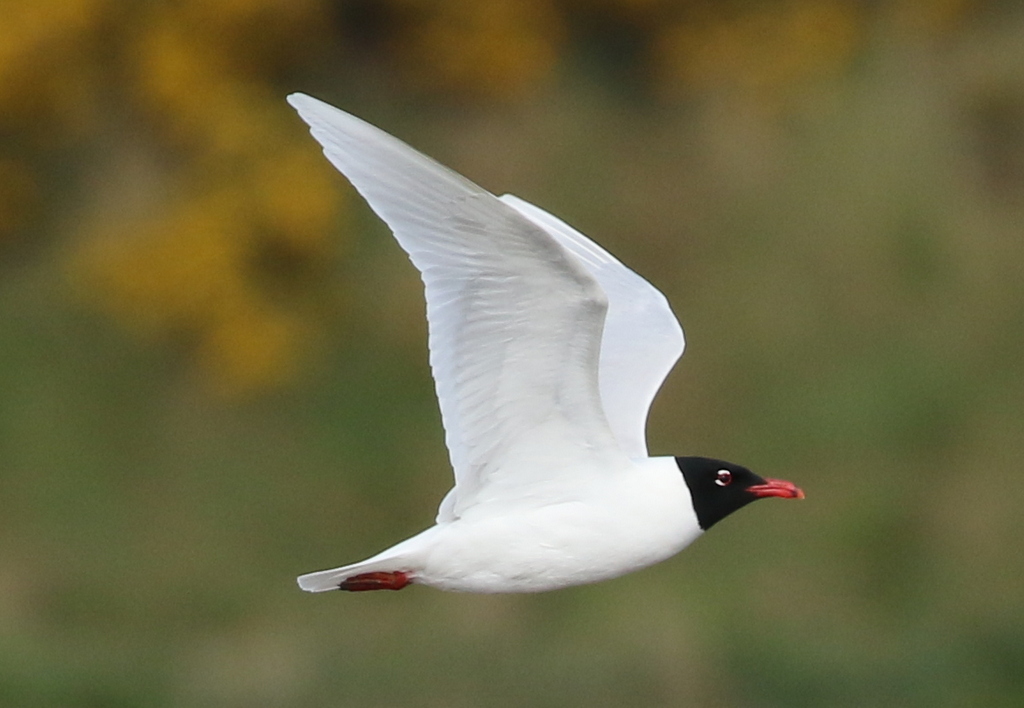
The tide was right out now but we had a quick walk round to look in the harbour. A Small Copper butterfly was basking on the gorse in the sun, the first we have seen this year. There were loads of Brent Geese loafing around on the mud in the harbour – it won’t be long now before they are on their way back to Siberia for the breeding season. There were some gulls out on the mud banks too, including several Great Black-backed Gulls.
We could see some very distant waders out on the mud in the middle, including several Bar-tailed Godwits, mostly now in bright rusty breeding plumage. One of them was carrying colour-rings, and we could make out a red flag on one thigh, but where it was walking most of its legs were hidden behind the mud in front.
Unfortunately it was time to start walking back now. We still managed to add a few birds to the day’s list on our way back to the van, a little group of Blue Tits and two Jays flying across the path into the wood. It had been another great day of spring migration birding out on the coast.
















